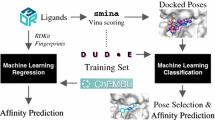Abstract
The rapid development of new machine learning techniques led to significant progress in the area of computer-aided drug design. However, despite the enormous predictive power of new methods, they lack explainability and are often used as black boxes. The most important decisions in drug discovery are still made by human experts who rely on intuitions and simplified representation of the field. We used D3R Grand Challenge 4 to model contributions of human experts during the prediction of the structure of protein–ligand complexes, and prediction of binding affinities for series of ligands in the context of absence or abundance of experimental data. We demonstrated that human decisions have a series of biases: a tendency to focus on easily identifiable protein–ligand interactions such as hydrogen bonds, and neglect for a more distributed and complex electrostatic interactions and solvation effects. While these biases still allow human experts to compete with blind algorithms in some areas, the underutilization of the information leads to significantly worse performance in data-rich tasks such as binding affinity prediction.







Similar content being viewed by others
References
Sunseri J, King JE, Francoeur PG, Koes DR (2019) J Comput Aided Mol Des 33(1):19
Zhong F, Xing J, Li X, Liu X, Fu Z, Xiong Z, Lu D, Wu X, Zhao J, Tan X, Li F, Luo X, Li Z, Chen K, Zheng M, Jiang H (2018) Sci China Life Sci 61(10):1191
Zhang L, Tan J, Han D, Zhu H (2017) Drug Discov Today 22(11):1680
Macalino SJ, Gosu V, Hong S, Choi S (2015) Arch Pharm Res 38(9):1686
Baig MH, Ahmad K, Rabbani G, Danishuddin M, Choi I (2018) Curr Neuropharmacol 16(6):740
(2018) Nat Biomed Eng 2:709
Holzinger A, Biemann C, Pattichis CS, Kell DB (2017) What do we need to build explainable AI systems for the medical domain? arXiv preprint arXiv https://arxiv.org/abs/1712.09923
Vassar R, Kovacs DM, Yan R, Wong PC (2009) J Neurosci 29(41):12787
Kitchen DB, Decornez H, Furr JR, Bajorath J (2004) Nat Rev Drug Discov 3(11):935
Liu J, Wang R (2015) J Chem Inf Model 55(3):475
Guedes IA, Pereira FSS, Dardenne LE (2018) Front Pharmacol 9:1089
Wilkinson RD, Williams R, Scott CJ, Burden RE (2015) Biol Chem 396(8):867
Ameriks MK, Bembenek SD, Burdett MT, Choong IC, Edwards JP, Gebauer D, Gu Y, Karlsson L, Purkey HE, Staker BL, Sun S, Thurmond RL, Zhu J (2010) Bioorg Med Chem Lett 20(14):4060
Wiener DK, Lee-Dutra A, Bembenek S, Nguyen S, Thurmond RL, Sun S, Karlsson L, Grice CA, Jones TK, Edwards JP (2010) Bioorg Med Chem Lett 20(7):2379
Ameriks MK, Axe FU, Bembenek SD, Edwards JP, Gu Y, Karlsson L, Randal M, Sun S, Thurmond RL, Zhu J (2009) Bioorg Med Chem Lett 19(21):6131
Levin NMB, Pintro VO, Bitencourt-Ferreira G, de Mattos BB, de Castro Silverio A, de Azevedo WF Jr (2018) Biophys Chem 235:1
Zhang L, Ai HX, Li SM, Qi MY, Zhao J, Zhao Q, Liu HS (2017) Oncotarget 8(47):83142
Park H, Eom JW, Kim YH (2014) J Chem Inf Model 54(7):2139
O'Boyle NM, Banck M, James CA, Morley C, Vandermeersch T, Hutchison GR (2011) J Cheminform 3(1):33
Cheeseright T, Mackey M, Rose S, Vinter A (2006) J Chem Inf Model 46(2):665
Stroganov OV, Novikov FN, Zeifman AA, Stroylov VS, Chilov GG (2011) Proteins 79(9):2693
Stroganov OV, Novikov FN, Stroylov VS, Kulkov V, Chilov GG (2008) J Chem Inf Model 48(12):2371
Ester M, Kriegel H-P, #246 S, Xu X. A density-based algorithm for discovering clusters a density-based algorithm for discovering clusters in large spatial databases with noise. Proceedings of the Second International Conference on Knowledge Discovery and Data Mining. Portland, Oregon: AAAI Press, 1996:226
Novikov FN, Stroylov VS, Stroganov OV, Chilov GG (2010) J Mol Model 16(7):1223
Machauer R, Laumen K, Veenstra S, Rondeau JM, Tintelnot-Blomley M, Betschart C, Jaton AL, Desrayaud S, Staufenbiel M, Rabe S, Paganetti P, Neumann U (2009) Bioorg Med Chem Lett 19(5):1366
Gaulton A, Bellis LJ, Bento AP, Chambers J, Davies M, Hersey A, Light Y, McGlinchey S, Michalovich D, Al-Lazikani B, Overington JP (2012) Nucleic Acids Res 40:D1100
Gaieb Z, Parks CD, Chiu M, Yang H, Shao C, Walters WP, Lambert MH, Nevins N, Bembenek SD, Ameriks MK, Mirzadegan T, Burley SK, Amaro RE, Gilson MK (2019) J Comput Aided Mol Des 33(1):1
Team RC. R: A language and environment for statistical computing. https://www.R-project.org/
The H2O.ai team. H2O: Scalable machine learning (2015), http://www.h2o.ai
The H2O.ai team. h2o: R Interface for H2O (2015), http://www.h2o.ai
Wolpert DH (1992) Neural Netw 5(2):241–259
Breiman L (2001) Mach Learn 45(1):5
Friedman JH (2001) Annals of statistics:1189
LeCun Y, Bengio Y, Hinton G (2015) Nature 521(7553):436
Carlson HA (2016) J Chem Inf Model 56(6):951
Taylor R, Kennard O, Versichel W (1984) Acta Cryst B40:280–288
Author information
Authors and Affiliations
Corresponding author
Additional information
Publisher's Note
Springer Nature remains neutral with regard to jurisdictional claims in published maps and institutional affiliations.
Electronic supplementary material
Below is the link to the electronic supplementary material.
Rights and permissions
About this article
Cite this article
Stroganov, O.V., Novikov, F.N., Medvedev, M.G. et al. The role of human in the loop: lessons from D3R challenge 4. J Comput Aided Mol Des 34, 121–130 (2020). https://doi.org/10.1007/s10822-020-00291-4
Received:
Accepted:
Published:
Issue Date:
DOI: https://doi.org/10.1007/s10822-020-00291-4




